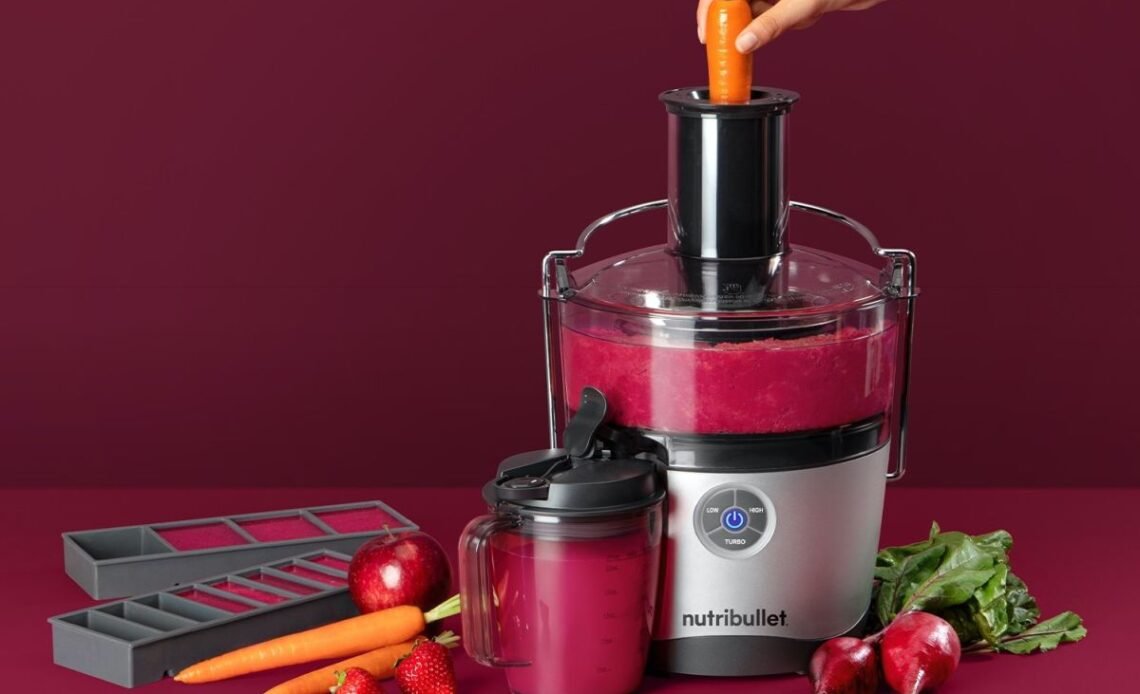It’s a debate that has been going on in kitchens and health food stores around the world – what is better for making healthy and nutritious drinks and smoothies – a slow juicer or a blender? They both have their advantages and disadvantages, and the decision of which one to use can be a difficult one. In this article, we’ll take a look at the differences between slow juicers and blenders, and how each can be used to make delicious and nutritious drinks and smoothies. So if you’re trying to decide which kitchen appliance is best for you, read on to find out more about slow juicers vs blenders!
| Slow Juicer | Blender |
|---|---|
| Produces a higher quality juice with more nutrients and enzymes | Produces a juice with fewer nutrients and enzymes |
| Produces more juice from the same amount of fruits/vegetables | Produces less juice from the same amount of fruits/vegetables |
| Juice can be stored for up to 72 hours | Juice must be consumed immediately |
| Can also be used to make nut milks, sorbets, and other items | Can be used to make smoothies and other drinks |
| More expensive | Less expensive |
For Short Time Readers
Chart Comparing: Slow Juicer Vs Blender
| Slow Juicer | Blender |
|---|---|
| Slow juicers are slow-speed machines that extract juice from fruits and vegetables using a masticating process. | Blenders are high-speed machines that use blades to blend ingredients together to create smoothies, sauces and other mixtures. |
| Slow juicers are more efficient in extracting juice from fruits and vegetables. | Blenders are more efficient in blending ingredients together. |
| Slow juicers are able to process fruits and vegetables with more fiber, like celery. | Blenders are not able to process more fibrous fruits and vegetables. |
| Slow juicers are able to extract the maximum amount of juice from fruits and vegetables. | Blenders are not able to extract the maximum amount of juice from fruits and vegetables. |
| Slow juicers are more expensive than blenders. | Blenders are less expensive than slow juicers. |
| Slow juicers are more time-consuming to use than blenders. | Blenders are faster to use than slow juicers. |
| Slow juicers are quieter than blenders. | Blenders are louder than slow juicers. |
| Slow juicers require more cleaning and maintenance than blenders. | Blenders require less cleaning and maintenance than slow juicers. |
| Slow juicers produce a higher quality juice than blenders. | Blenders produce a lower quality juice than slow juicers. |
Slow Juicer vs Blender: What’s the Difference?
Juicing and blending are two popular methods of getting the most out of your fruits and vegetables. Both extract the nutrients and vitamins that are essential for a healthy diet. But how do you know when to use a slow juicer or a blender? In this article, we’ll be taking a look at the differences between the two so you can make an informed decision.
Health Benefits
Slow juicers are known for their ability to extract the maximum amount of nutrients from fruits and vegetables. By using a slow-speed auger, the juice is extracted with minimal oxidation, which preserves the vitamins and minerals that are beneficial for your health. Slow juicers also produce higher yields and less pulp than regular juicers.
On the other hand, blending is a great way to get all of the fiber and vitamins from your fruits and vegetables. Blending breaks down the cell walls of the produce, which makes it easier for your body to absorb the nutrients. Blenders also make it easy to mix in other ingredients like nuts, seeds, and superfoods.
Taste and Texture
When it comes to taste and texture, juicing and blending are two completely different experiences. Juices are smooth and refreshing, while blended drinks tend to be thicker and creamier. Juices are also more concentrated and flavorful, which makes them great for people who want to get the most out of their produce.
Blended drinks, on the other hand, are a great option for those who prefer a thicker texture. They are usually richer and creamier, and are great for making smoothies, milkshakes, and other creative beverages. Blended drinks also mix well with other ingredients, which makes them perfect for creating unique and flavorful concoctions.
Preparation and Clean-up
Both juicing and blending require some preparation and clean-up. For juicing, you’ll need to cut and peel your fruits and vegetables before putting them through the juicer. This can be a time-consuming process depending on what produce you’re using. After juicing, you’ll need to clean the juicer and any other parts that were used.
Blending is much less time-consuming since you don’t need to cut and peel the produce. All you need to do is throw all of the ingredients into the blender and let it do its job. Clean-up is also much easier since you only need to wash the blender and any other parts that were used.
Cost
When it comes to cost, juicers and blenders can be quite expensive. Slow juicers are usually the most expensive option since they come with specialized features, such as the slow-speed auger and higher yields.
Blenders, on the other hand, can range from budget-friendly models to more expensive options. The cost of a blender will depend on its features and what type of motor it has.
Which Is Better for You?
The best option for you will depend on your needs and preferences. If you’re looking for a way to get the most nutrients out of your fruits and vegetables, then a slow juicer is the way to go. If you prefer a thicker texture and don’t mind a bit of extra work, then a blender is the right choice.
Slow Juicer vs Blender Pros & Cons
Pros of Slow Juicer:
- Higher nutrient content
- Good for juicing leafy greens
- No oxidation
- Higher juice yield
Cons of Slow Juicer:
- Higher price
- Time consuming
- Can be difficult to clean
Pros of Blender:
- Easy to use
- Inexpensive
- Quick to clean
- Can make smoothies and soups
Cons of Blender:
- Oxidation of nutrients
- Lower nutrient content
- Not suitable for juicing leafy greens
- Lower juice yield
Which is Better – Slow Juicer vs Blender?
When it comes to choosing between a slow juicer and a blender, the best option for you depends on your lifestyle and needs. Depending on what type of food and drink you want to make, you may need to choose between one or the other.
A slow juicer is best for making pure juices from fruits, vegetables, and leafy greens. It uses a cold press method to extract the juice from the ingredients, resulting in more vitamins, minerals, and enzymes left intact. A slow juicer is also more efficient and can extract more juice from the same ingredients than a blender.
A blender is great for making smoothies and other drinks, as well as soups, sauces, and dips. With a blender, you can also chop, grind, and mix ingredients together. A blender is also less expensive than a slow juicer.
Overall, the best choice between a slow juicer and a blender will depend on your needs. If you’re looking for more nutrition and efficiency, then a slow juicer is the better option. However, if you’re looking for an affordable, versatile appliance, then a blender is the better option.
Here are three reasons why a slow juicer is the best choice:
- It extracts more juice from the same ingredients.
- It preserves more vitamins, minerals, and enzymes.
- It’s more efficient and uses less energy.
Frequently Asked Questions
Slow juicers and blenders are two common kitchen appliances used for different food preparation tasks. Each appliance has their own advantages and disadvantages and each is best suited for specific tasks. To help you decide which appliance is best for you, here are some frequently asked questions about slow juicers and blenders.
What is the difference between a slow juicer and a blender?
A slow juicer is a specialized appliance that extracts juice from fruits, vegetables and leafy greens by slowly squeezing or crushing them. It works by slowly crushing the produce, which helps to gently extract the juice from the pulp, allowing for a more nutrient-dense juice. In contrast, a blender uses blades to rapidly chop and blend ingredients to create smoothies, soups, sauces, and more. Blenders are best suited for tasks that require a smooth texture, such as creating a smoothie or pureeing vegetables for soup.
Which appliance is better for juicing?
When it comes to juicing, a slow juicer is the better option. Slow juicers are specifically designed to extract the maximum amount of nutrients and juice from fruits, vegetables and leafy greens. This is because they slowly crush the produce, allowing for a more efficient extraction of juice. In contrast, blenders are not designed to extract juice from produce, and the blades can pulverize the produce, resulting in a less nutrient-dense juice.
Which appliance is better for making smoothies?
When it comes to making smoothies, a blender is your best bet. Blenders use rapidly spinning blades to chop and blend ingredients, which helps to create a smooth and consistent texture. In contrast, slow juicers are not able to blend ingredients, and the slowly crushing action can result in a pulpy texture.
What are the advantages of a slow juicer?
One of the main advantages of a slow juicer is that it is able to extract the maximum amount of nutrients and juice from fruits, vegetables and leafy greens. This is due to the slowly crushing action, which helps to gently extract the juice from the pulp. Furthermore, slow juicers are also quieter, more energy efficient and easier to clean than blenders.
What are the advantages of a blender?
Blenders are best suited for tasks that require a smooth texture, such as creating a smoothie or pureeing vegetables for soup. The rapidly spinning blades are able to chop and blend ingredients quickly and efficiently, resulting in a smooth texture. Furthermore, blenders are also more versatile than slow juicers, as they can be used to create a variety of dishes, such as soups, sauces, dips and more.
Jason Vale’s Juicing Vs Blending Guide
When it comes to making healthy, nutritious meals and snacks, a slow juicer and a blender are two powerful tools. Both are great for creating smoothies, juices, and other purees, but a slow juicer is better for preserving nutrients and enzymes in fruits and vegetables, while a blender is better for making quick, nutrient-dense drinks. Ultimately, the choice between a slow juicer and a blender depends on your needs and preferences. If you’re looking for maximum nutrition and a slow, thorough extraction, a slow juicer is the way to go. If you’re looking for quick, easy drinks with a lot of flavor and texture, a blender is the way to go.




